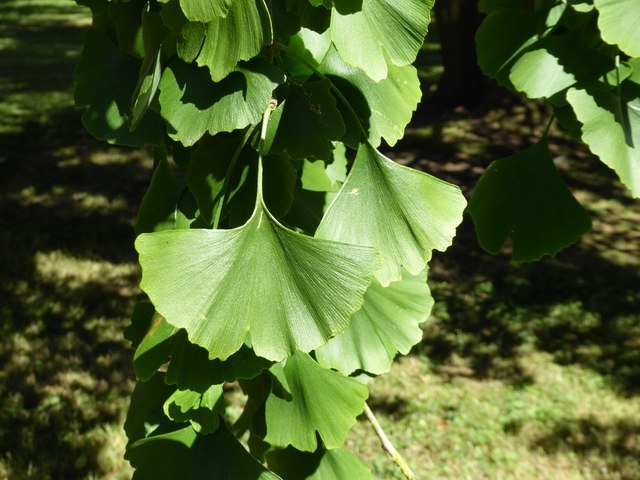This is the first of a two part series on the ginkgo tree. The following examines the tree’s habitat, developmental traits, longevity, height, bark, leaves, seeds, and propagation methods.
Introduction
The ginkgo tree (Ginkgo biloba), also known as Baugio tree, fossil tree, Japanese silver apricot, maidenhair tree, and yinhsing, is the oldest recorded tree species on Earth. Fossilized ginkgo trees have been discovered that date back 270 million years. Ginkgo is the only surviving tree to be classified in the division Ginkgophyta.
The ginkgo tree is native to China. It was first described by Carl Linnaeus, a Swedish botanist, in 1771. Its name is a mistranslation of the Japanese word gin kyo, which means silver apricot. Ginkgo is widely cultivated in North America, Europe, and Asia. It is renown for its characteristic fan-shaped foliage, resplendent autumn color, and general hardiness. Many herbal supplements are derived from Ginkgo, and used to treat various maladies.
Distribution & Habitat
The ginkgo tree is distributed across much of North America, Europe, and Asia. In North America and Europe, it is typically cultivated, and rarely naturalized. It is often used as a planting along streets, highways, and walkways, as well as in parks and landscapes. Ginkgo occurs in much of its native territory. It is especially abundant in China, Japan, and Korea, where it is often selected for planting in gardens and yards. Wild ginkgo trees are generally found in deciduous forests and valleys.
Developmental Traits
Ginkgo can grow in a multitude of settings, ranging from landscapes and gardens to forests and mountains. It is also sometimes found growing along ridges, and near streams. Ginkgo establishes an upright central leader, with a crown that becomes broader as the tree matures. Young ginkgo trees are often tall and slender.
Longevity
Ginkgo is a hardy tree with a long lifespan. It can live for at least 1,000 years.
Height
Ginkgo is a large tree that can reach heights of up to 170 feet. The average height of a ginkgo tree is 66 to 115 feet.
Bark
The ginkgo tree’s bark is brownish gray. It is deeply furrowed, and becomes heavily ridged when older.
Leaves
Ginkgo leaves have a distinct fan-like shape. The leaf veins radiate outward towards the leaf blade. The leaves on longer branches are typically notched or lobed on the outer surface, between the leaf veins. The branches tend to be short, measuring 2 to 4 inches in diameter. Some branches may grow up to 6 inches long. Ginkgo trees are sparsely branched when first developing. As they mature, ginkgo trees become flush with growth. During the growing season, ginkgo leaves are colored green. In fall, they turn bright yellow. Ginkgo’s autumn color persists for several weeks. Soon, the color fades, and the leaves are abruptly cast from the tree. While notable for their shape, ginkgo leaves are also known for containing flavanoids and terpenoids, antioxidants that when consumed, can help prevent DNA and other vital cells from being damaged by free radicals in the body.
Fruit
Ginkgo trees are dioecious; some trees are females, while others are males. The male ginkgo trees form tiny cones filled with pollen. The female gingko trees develop two ovules at the end of a stalk. The cones release pollen, which are disseminated by the wind to the ovules of nearby females. The ovules are fertilized by the pollen, and begin producing tiny fruit-like structures that resemble apricots, but are actually seeds. Each seed measures 1.5 to 2 cm long. The seeds have a hard shell, which is composed of two sections: the sarcotesta (the soft and fleshy outer layer), and the sclerotesta (the hard and rigid inner layer). The sarcotesta is colored yellow-brown. The seeds exude a pungent odor, and can be toxic when consumed in abundance.
Seed Propagation
Many ginkgo trees are propagated from cuttings and seeds. Cuttings are ideal for controlling the sex of the tree. From late spring to mid-summer, cuttings can be collected, and planted in moist soil, where they will take root. Monitor the trees as they develop, and ensure that they are sufficiently watered, maintained, and mulched.
To successfully propagate a ginkgo tree from seed, collect a batch of fresh ginkgo seeds in fall. Using protective gloves, remove the fleshy exterior of the seeds. Wash the seeds thoroughly, and allow them to dry. Create a small perforation in each seed, and then soak them in warm water for 24 hours. Next, submerge the seeds in a solution composed of one part bleach and nine parts water. This will cleanse the seeds of most bacteria, and stave off fungal infections. Remove the seeds from the mixture, and rinse them off. Plant the seeds in moist soil, and allow them to germinate for 30 to 60 days.
Occasionally, ginkgo trees may be propagated through grafting. The branches of male gingko trees are grafted onto female trees, which results in the females being fertilized. Grafting is an efficient propagation method, but it is generally not advised, as it can result in the deformation of the female tree’s dominant leader.
Additional Resources
https://kwanten.home.xs4all.nl/hiroshima.htm
Photo courtesy of Philip Halling CC-by-2.0


